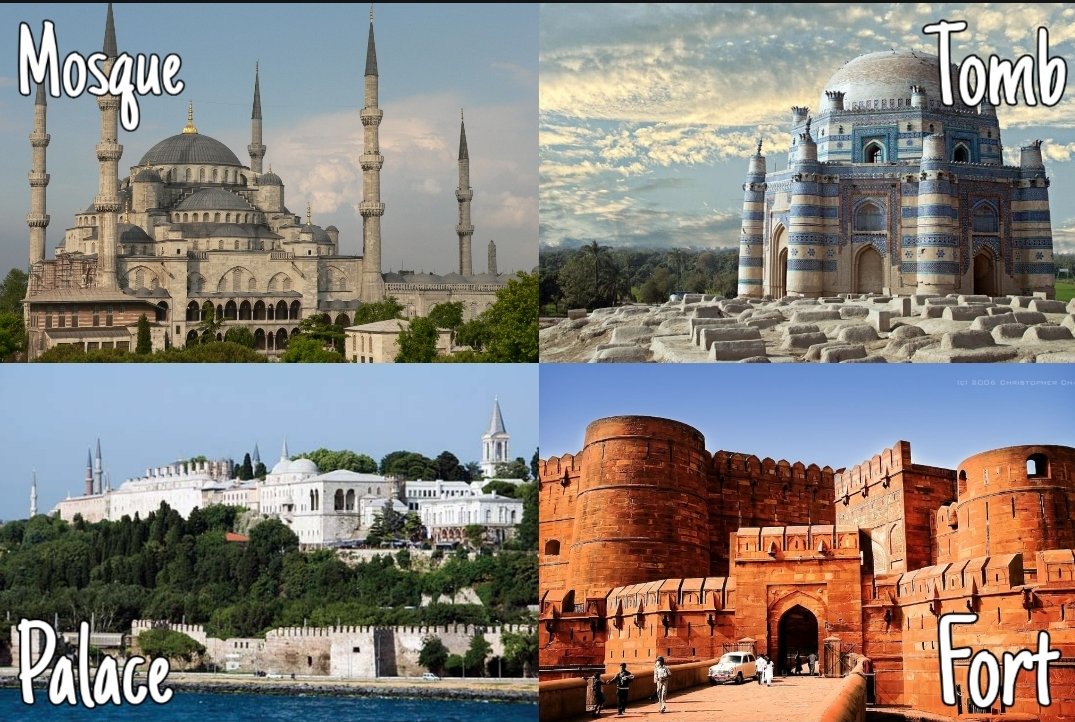
Since this week's #WyrdWednesday theme is architecture, I've decided to write a thread for you all on Islamic architecture and the beliefs and symbolism behind it! I hope you all enjoy this thread on this beautiful and spectacular architectural form. 🕌☪️ 1/ 

Islamic architecture has been influenced by Roman, Byzantine, Persian, Mesopotamian, Chinese, and Mughal architecture. (Although I think you'll find it has a flavor all its own!) The four main forms of Islamic architecture are mosque, tomb, palace, and fort. 2/ 

Islamic architecture is often referred to as "architecture of the veil" because the most beautiful aspects of it are inside of it. 3/ 

Water and gardens are important in Islamic culture, symbolizing the garden of Paradise. A feature of Persian Islamic architecture is the Charbagh, which is a rectangular garden divided by walkways or water into four equal sections. It represents the four gardens of Paradise. 4/ 

Another important feature of Islamic architecture is the central courtyard. This is present both in traditional homes and in mosques, where it is known as a ṣaḥn (صحن). Sahns typically feature a pool of water under an open domed pavilion (howz) used for ablutions. 5/ 

Ablutions are processes of ritual purification, known in Islam as wudu or الوضوء (al-wuḍūʼ). It is practiced before prayer and before touching and reading the Quran. So you can see how having this pool of water would be important. 6/ 

Another prominent feature in Islamic architecture are domes. The intricately decorated dome interiors and ceilings of many buildings symbolically represent the heavens. 7/ 

Muqarnas are one of my favorite types of decorative features in Islamic architecture. They originated in northeast Iran and the Maghreb and are geometric three dimensional miniature vaulted ornaments. It represents universal creation by God. 8/ 

Islamic architecture is very intricately & beautifully decorated. These decorations generally take the form of arabesque, geometric, & calligraphic designs. Depictions of people & animals are typically not used as some Muslims consider such depictions to be haram (forbidden) 9/ 

Arabesque is a form of decoration which consists of interlacing floral and tendril designs. The flowers and plants featured tend to not have any basis in real flowers and are instead imagined flowers. Arabesque is often considered to represent the Islamic view of the world. 10/ 

Geometric patterns are mathematically rooted & tend to be highly symbolic. For example, the four sides of a square represent the four elements: water, earth, air, & fire. Circles represent diversity & unity. Most geometric designs are based on interlocking circles & squares. 11/ 

Calligraphy is an incredibly important form of Islamic art on its own & is frequently used in decoration. It is viewed as a visual manifestation of spiritual concepts. Seyyed Hossein Nasr describes it as "the response of the soul of Muslims to the Quranic revelation." 12/ 

Features of Islamic architecture are not just symbolic, but also have practical religious applications. One of these is that traditionally buildings, especially mosques, are built facing Qibla (قِـبْـلَـة), the direction of prayer. This allows Muslims to easily find Qibla. 13/ 

Mosques feature a Mihrab (محراب) which is a semicircular niche in the wall indicating Qibla. Architecture is also used more subtley to guide Muslims into proper prayer. 14/ 

Islamic architecture is wholly symbolic, with the interlocking and repeating patterns representing Allah's infinite power, and Islamic architecture itself often being viewed as sacred and a manifestation of Islam. I will leave you with one more quote by Seyyed Hossein Nasr: 15/ 

"Architecture itself is a sacred art because it grows from and finds its highest expression in the architecture of the mosque, whose very spaces are defined by the reverberations of the recitation and chanting of the Quran." 16/16 

@threadreaderapp pls unroll pls
• • •
Missing some Tweet in this thread? You can try to
force a refresh













